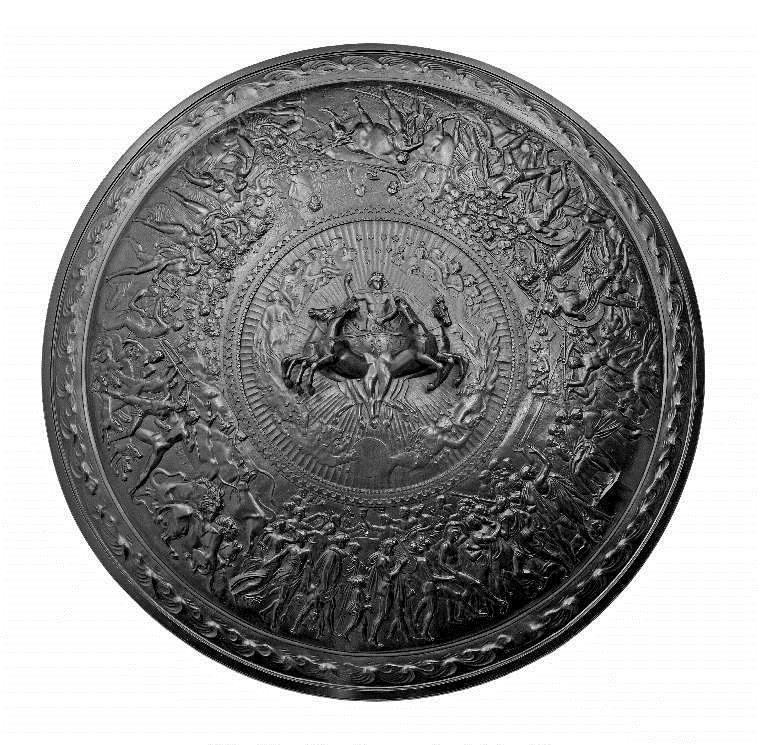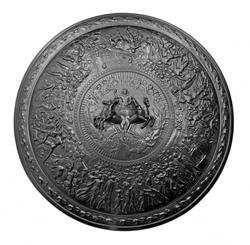Current Location: In storage
Titles
The Shield of Achilles
Maker(s)
Designer:
Flaxman, John
(After)
Maker:
Rundell, Bridge and Rundell
Chaser:
Pitts, William
(Probably)
Entities
Categories
Description
Bronze, cast and chased. The design is inspired by the shield forged by the Greek god Hephaestus for Achilles during the war between the Greeks and the Trojans, and is described in detail in book 18 of Homer's 'Iliad' (lines 478-609). During the course of the war between the Greeks and the Trojans, Achilles' close friend Patroclus was killed by the Trojan king's son Hector, whilst leading the Greeks disguised as Achilles. Hector took Achilles' armour from Patroclus' body. Achilles' mother, the nymph Thetis, asked Hephaestus to make a new set of armour for her son. Grief-stricken after the death of his friend, Achilles then wore the armour and used the shield in his famous fight against Hector, whom he killed. The centre of the shield depicts the heavens, with the chariot of the Sun surrounded by the constellations. The reliefs radiating outwards, around the centre of the shield, begin at the bottom with (1) the marriage procession and banquet, and proceed in an anticlockwise direction with: (2) the quarrel of citizens over a homicide and the judicial appeal by elders; (3) the siege and ambuscade; (4) the harvest field; (5) the grape harvest; (6) the shepherds defending their flocks; and (7) the Cretan dance. The border depicts the oceans. On the reverse there are four rings for suspension at the top, and a cross bar with a central hole. The reverse is engraved close to the edge 'DESIGNED AND MODELLED BY JOHN FLAXMAN RA/EXECUTED BY RUNDELL BRIDGE & RUNDELL JEWELLERS TO HIS MAJESTY/MDCCXXIV' (1824)
Notes
History note: Cast by Messrs. Rundell & Bridge
Legal notes
Given by Rundell and Bridge
Measurements and weight
Diameter: 89.5 cm
Acquisition and important dates
Method of acquisition: Given
(1842)
by
Rundell & Bridge
Dating
19th Century, Early
George IV
Production date:
AD 1824
: dated
Note
It is unclear whether the idea for the shield came from Rundell, Bridge and Rundell, the London-based royal goldsmiths and jewellers, or from John Flaxman. Nor is the exact date of the commission to Flaxman known. The first documented reference to the shield is in a letter of 29 October 1810 from Rundell, Bridge and Rundell, in which a payment of 100 guineas 'for the beautiful design of the shield of Achilles' is mentioned (volume of autograph letters to the poet William Hayley, now Fitzwilliam Museum, fol. 98). Flaxman recorded a further payment of £200 for the design on 4 January 1817 in his ledger, and a payment of £525 for the model on 20 January 1818. The model was probably made in wax or clay. It was then cast in plaster, and the finer details carved into it. It appears that three (or more) bronze casts were made (documented as finished by William Pitts), followed by the first cast in silver in summer 1819. The latter was probably the silver gilt cast bought by George IV in early 1821 (hallmarked for 1821-22), which was displayed at the coronation banquet that same year and remains in the Royal Collection. A total of five silver gilt casts were made. A limited edition of probably only three casts in plaster was also made. The present bronze cast is dated 1824.
School or Style
Neoclassical
People, subjects and objects depicted
Project
Components of the work
Details
Materials used in production
Bronze
Techniques used in production
Casting
: Bronze, cast and chased
References and bibliographic entries
Related exhibitions
Identification numbers
Accession number: M.1-1842
Primary reference Number: 12198
External ID: CAM_CCF_M_1_1842
Stable URI
Audit data
Created: Saturday 6 August 2011
Updated: Monday 25 March 2024
Last processed: Tuesday 13 May 2025
Associated departments & institutions
Owner or interested party:
The Fitzwilliam Museum
Associated department:
Applied Arts

 IIIF Manifest
IIIF Manifest




